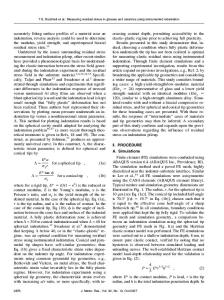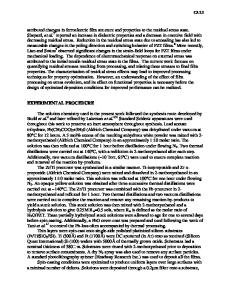Effects of strain hardening and residual stress in impression on the instrumented indentation technique
- PDF / 356,803 Bytes
- 7 Pages / 585 x 783 pts Page_size
- 74 Downloads / 455 Views
Y.W. Bao Shenyang National Laboratory for Materials Science, Institute of Metal Research, Chinese Academy of Sciences, Shenyang 110016, People’s Republic of China; and China Building Materials Academy, Guanzhuang, Beijing 100024, People’s Republic of China
Y.C. Zhoua) Shenyang National Laboratory for Materials Science, Institute of Metal Research, Chinese Academy of Sciences, Shenyang 110016, People’s Republic of China (Received 8 September 2005; accepted 5 January 2006)
Finite element analyses were carried out to simulate the loading, unloading, and reloading processes of indentation tests. It was found that the validity of applying the elastic contact theory to the indentation unloading process is strongly related to the strain hardening and residual stress in impression. It is the combination of strain hardening and residual stress that causes the unloading or reloading curves to show elastic loading in the range from zero to the maximum load whereas the reloading curve on the impression without strain hardening and residual stress shows elastic– plastic loading in the same range. These computations indicate that applying the elastic contact theory to the unloading or reloading processes, the fundamental prerequisite of the instrumented indentation technique, is valid because of the existence of strain hardening and residual stress. The mechanism of this hardening effect is discussed through energy analysis.
I. INTRODUCTION
The instrumented indentation technique has been used increasingly to probe the mechanical response of structural materials. Much research has been devoted to various theoretical analyses such as scaling and dimensional analysis,1–3 the concept of effective indenter shape,4–6 the similarity approach,7 the simplified method,8 the size effect of materials,9 and so on. The analysis procedure of load–displacement curves is often based on the work of Doerner and Nix10 or Oliver and Pharr.11 Their analyses are mostly based upon the elastic relationships developed by Sneddon12 for the penetration of a flat elastic halfspace by different probes with particular axisymmetric shapes. After a loading–unloading cycle in indentation tests, an impression is formed with strain hardening effect and residual stress in the materials. In the Oliver–Pharr method, the most important assumption is that the elastic recovery occurs during the entire unloading. It is the
a)
Address all correspondence to this author. e-mail: [email protected] DOI: 10.1557/JMR.2006.0213 1680 J. Mater. Res., Vol. 21, No. 7, Jul 2006 http://journals.cambridge.org Downloaded: 18 Mar 2015
elastic nature of the unloading curve that facilitates the analysis of instrumented indentation data.13 Thus the elastic unloading process is equivalent to the elastic reloading process of the same indenter on the impression with strain hardening and residual stress, which is further simulated by an elastic loading process of an effectively shaped indenter on an unstressed, flat, semi-infinite space without strain hardening.4–6 The inhomogeneous residua
Data Loading...











